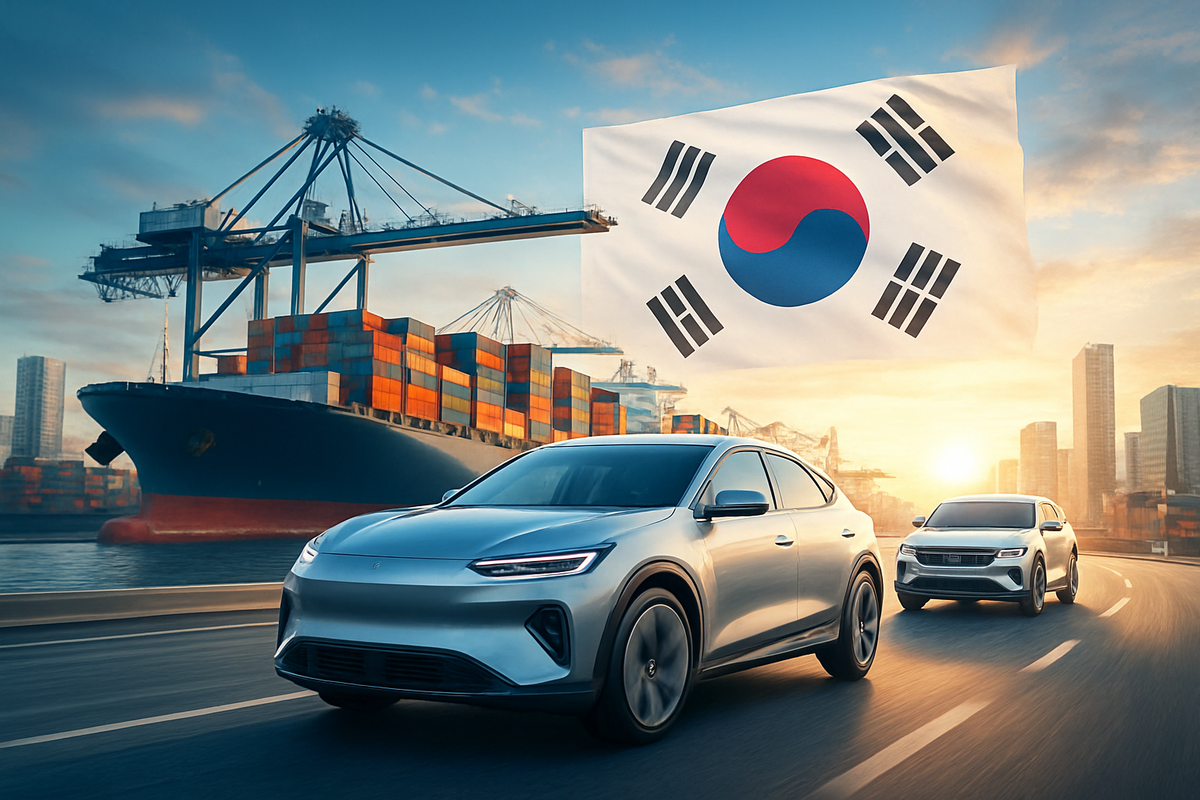
South Korea's automotive industry has achieved a remarkable feat, with its auto exports reaching unprecedented levels in 2025. Despite facing significant headwinds, particularly a 25% "Trump tariff" imposed by the United States, Korean automakers have demonstrated impressive resilience and strategic adaptability, leading to record-breaking export values. This surge, primarily driven by robust demand for eco-friendly vehicles and a strategic redirection of exports, signals a pivotal moment for the global automotive landscape and underscores the dynamic nature of international trade relations. The record performance highlights a successful navigation of protectionist policies and a proactive embrace of future automotive trends, with profound implications for major players and market dynamics worldwide.
Navigating Tariffs: A Deep Dive into Korea's Export Triumph
The journey to record-high auto exports for South Korea has been marked by strategic shifts and a focus on emerging market demands. As of November 20, 2025, cumulative automobile exports from January to October 2025 have hit an all-time high of $59.6 billion, marking a new record for the second consecutive year. This impressive figure comes even with a monthly dip in October, largely attributed to fewer working days due to the shifting Chuseok holiday.
The timeline of this success reveals several key drivers. September 2025 saw a monthly record with exports soaring by 16.8% year-on-year to $6.41 billion. This momentum was partially sustained by increased production days. A significant factor in this growth has been the burgeoning demand for eco-friendly vehicles. In September 2025, eco-friendly vehicle exports surpassed 90,000 units for the first time, with electric vehicle (EV) exports rising by 38.9% and hybrid vehicle exports surging by 55.7%. This trend continued into October, with eco-friendly car exports gaining 0.9% year-on-year to 64,427 vehicles, valued at $2 billion. The average export price of Korean cars also reached a record high of $25,224 in the first half of 2024, reflecting a global preference for premium models, SUVs, and environmentally conscious vehicles.
Key players like Hyundai Motor Group (KRX: 005380) and Kia Corporation (KRX: 000270) have been instrumental in this success, adapting their production and export strategies. While the United States, historically South Korea's largest market, has seen a consistent decline in imports of Korean automobiles for seven to eight consecutive months due to the 25% tariff, Korean automakers have deftly diversified their export destinations. Exports to the European Union (EU) surged by 52.8% in September 2025, and shipments to Asia increased significantly by 62.3% in the same month, effectively compensating for the reduction in U.S. demand. Furthermore, an unexpected surge in used car exports, particularly to Russia, Central Asia, and the Middle East, has emerged as a crucial buffer, driven by geopolitical realignments and a weaker Korean Won. This market diversification and product innovation have been key to the industry's resilience.
Winners and Losers: Corporate Impacts in a Shifting Landscape
The record performance of Korean auto exports creates a clear delineation of winners and those facing increased pressure within the global automotive industry. Foremost among the beneficiaries are Hyundai Motor Company (KRX: 005380) and Kia Corporation (KRX: 000270). These two giants of the Korean automotive sector are directly responsible for the bulk of the export volume and value. Their strategic investments in eco-friendly vehicle technology, including EVs and hybrids, have positioned them perfectly to capitalize on the global shift towards sustainable mobility. The increased average export price, driven by demand for their premium models and SUVs, directly translates to higher revenues and profitability for these companies. Furthermore, their proactive expansion of overseas production facilities in regions like the U.S., Czech Republic, India, and Mexico helps mitigate the impact of trade barriers and allows them to cater to local demand more efficiently. The anticipated reduction in U.S. auto tariffs from 25% to 15% is also a significant win, potentially reversing the decline in U.S.-bound exports and boosting their market share in a critical region.
On the other hand, traditional automotive manufacturers in other regions, particularly those heavily reliant on internal combustion engine (ICE) vehicles or those facing stiff competition in the EV segment, might find themselves under increased pressure. Companies that have been slower to adapt to the eco-friendly vehicle trend or those with less diversified export markets could see their market share eroded by the aggressive expansion of Korean brands. While specific "losers" are harder to pinpoint without direct financial reports, the competitive landscape intensifies for automakers globally. For instance, some European and Japanese manufacturers might face heightened competition in the EU and Asian markets, where Korean exports are now surging. The rise of used car exports from Korea also presents a unique challenge to new car sales in certain developing markets, potentially affecting manufacturers who target those segments.
The significant $86 billion investment by Hyundai Motor Group (KRX: 005380) in South Korea between 2026 and 2030, focusing on AI, R&D, and production capacity, underscores a long-term commitment that will further solidify their competitive advantage. This investment, spurred by the new U.S.-South Korea trade agreement, is expected to boost domestic production and vehicle exports by 13% by 2030, indicating a potential "reshoring" trend and a strategic pivot towards strengthening their domestic manufacturing base while leveraging international production for market access.
Broader Implications for the Global Automotive Landscape
The record performance of Korean auto exports is not an isolated event but rather a significant indicator of broader industry trends and shifts in global trade. This success story highlights the increasing importance of eco-friendly vehicles as the primary growth engine for the automotive sector. Korean automakers' robust performance in EV and hybrid exports signals a successful adaptation to the global push for sustainability, setting a precedent for how manufacturers can thrive amidst environmental regulations and consumer demand shifts. This trend is likely to intensify competition in the EV market, particularly as Chinese manufacturers also expand their presence, creating a highly dynamic and competitive environment for technological innovation and market penetration.
The strategic diversification of export markets, moving away from a heavy reliance on the U.S. due to tariffs, showcases a proactive approach to mitigating geopolitical risks. The surge in exports to the EU and Asia demonstrates that automakers can successfully reorient their trade flows in response to protectionist policies. This has potential ripple effects, prompting other exporting nations to re-evaluate their own market diversification strategies and potentially leading to a more fragmented, yet resilient, global supply chain. The unexpected boom in used car exports to regions like Russia, Central Asia, and the Middle East further underscores the adaptability of the Korean auto industry. This phenomenon, driven by geopolitical realignments and economic factors, reveals a structural shift, where second-hand vehicles are becoming a crucial export buffer, offering lessons in leveraging secondary markets during periods of instability.
Regulatory and policy implications are also profound. The imposition of the 25% U.S. "Trump tariff" and the subsequent negotiation of a new U.S.-South Korea trade agreement to lower tariffs to 15% exemplify the continuous interplay between trade policy and industrial strategy. This situation highlights how governmental decisions can directly influence corporate investment and export strategies, as seen with Hyundai Motor Group's massive domestic investment following the tariff reduction agreement. Historically, similar trade disputes, such as those involving Japanese automakers in the 1980s, have often led to increased overseas production and strategic alliances to circumvent trade barriers. The current scenario with Korean automakers reflects a similar pattern of strategic adaptation, but with a heightened focus on technology and market diversification. The Korean Automobile Manufacturers Association (KAMA)'s call for government support in labor relations and flexible working systems also indicates the ongoing need for policy frameworks that support export growth amidst global uncertainties.
The Road Ahead: Future Prospects and Challenges
Looking ahead, the trajectory of Korean auto exports suggests a dynamic and evolving future for the global automotive industry. In the short term, the anticipated reduction of U.S. auto tariffs from 25% to 15% is poised to be a significant catalyst, potentially revitalizing exports to the crucial North American market. This could lead to a rebound in sales for Korean brands in the U.S., although the strategic pivot towards overseas production facilities by companies like Hyundai and Kia will continue to influence direct export figures. The sustained global demand for eco-friendly vehicles, particularly hybrids and EVs, will remain a key driver, pushing Korean automakers to further innovate and expand their offerings in this segment.
In the long term, several strategic pivots and adaptations will be crucial. The substantial $86 billion investment by Hyundai Motor Group (KRX: 005380) in South Korea, spanning 2026 to 2030, signals a strategic "reshoring" trend aimed at bolstering domestic production capacity, R&D, and AI integration. This investment is expected to increase domestic production and vehicle exports by 13% by 2030, indicating a long-term commitment to strengthening the domestic manufacturing base while leveraging international facilities for market access and tariff mitigation. Market opportunities will continue to emerge in regions showing strong demand for eco-friendly vehicles and in developing markets that are receptive to both new and used Korean automobiles.
However, challenges persist. The reliance on used car exports to geopolitically volatile regions introduces inherent risks, as evidenced by the decrease in exports to the Middle East due to the Israel-Iran conflict. Sustaining growth in these markets will require careful monitoring of geopolitical stability. Furthermore, intense competition from other global automakers, particularly in the rapidly expanding EV sector, will necessitate continuous innovation and cost-effectiveness. Potential scenarios include a further acceleration in the global adoption of EVs, leading to increased demand for Korean offerings, or conversely, a slowdown in certain markets due to infrastructure limitations or economic downturns. The ability of Korean automakers to navigate these complexities through technological leadership, flexible manufacturing, and astute market diversification will determine their sustained success.
A Resilient Drive: Key Takeaways and Future Outlook
The record-high performance of Korean auto exports in 2025 stands as a testament to the industry's resilience and strategic foresight in navigating a complex global trade environment. The key takeaways from this event underscore the critical role of eco-friendly vehicles as the primary growth engine, the effectiveness of market diversification in mitigating protectionist policies, and the strategic importance of overseas production and domestic investment in securing long-term competitiveness. The ability of Korean automakers, particularly Hyundai Motor Company (KRX: 005380) and Kia Corporation (KRX: 000270), to adapt swiftly to changing consumer preferences and geopolitical realities has been central to their success.
Moving forward, the market will likely see continued robust performance from Korean auto exports, albeit with shifts in geographical distribution. The anticipated reduction in U.S. tariffs, coupled with significant domestic investments, positions the industry for sustained growth. Investors should closely watch several factors in the coming months: the actual impact of the revised U.S.-South Korea trade agreement on export volumes, the continued growth trajectory of eco-friendly vehicle sales globally, and the stability of emerging markets for used car exports. Furthermore, monitoring the ongoing innovation in EV technology and battery production by Korean manufacturers will be crucial, as these will be key determinants of future market leadership. The Korean automotive industry is not merely weathering the storm of global trade; it is actively reshaping its destiny, setting a precedent for agility and strategic adaptation in the face of unprecedented challenges.
This content is intended for informational purposes only and is not financial advice





